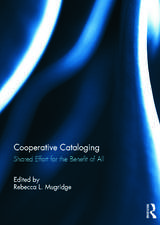Understanding Manga and Anime
Autor Robin E. Brenneren Limba Engleză Paperback – 29 iun 2007 – vârsta până la 17 ani
Preț: 267.92 lei
Preț vechi: 341.70 lei
-22% Nou
Puncte Express: 402
Preț estimativ în valută:
51.27€ • 53.33$ • 42.33£
51.27€ • 53.33$ • 42.33£
Carte tipărită la comandă
Livrare economică 15-29 aprilie
Preluare comenzi: 021 569.72.76
Specificații
ISBN-13: 9781591583325
ISBN-10: 1591583322
Pagini: 356
Dimensiuni: 156 x 235 x 25 mm
Greutate: 0.55 kg
Editura: Bloomsbury Publishing
Colecția Libraries Unlimited
Locul publicării:New York, United States
ISBN-10: 1591583322
Pagini: 356
Dimensiuni: 156 x 235 x 25 mm
Greutate: 0.55 kg
Editura: Bloomsbury Publishing
Colecția Libraries Unlimited
Locul publicării:New York, United States
Notă biografică
Robin E. Brenner is the Teen Librarian at the Brookline Public Library in Massachusetts. She has created and leads a successful Japanese manga and anime club for teens. She is a member of the ALA/YALSA Great Graphic Novels for Teens Selection List Committee, a list she was chosen to help establish, and she co-authored the RUSA graphic novel reviewing guidelines and the Getting Graphic at Your Library workshop guidelines. In addition, she reviews manga for Booklist, reviews Japanese anime for Video Librarian, and she regularly speaks and conducts workshops on graphic novels, manga, and anime. She also hosts a Web site on graphic novels, www.noflyingnotights.com, and two sister sites (Sidekicks, for children thru age 12 and the Lair, for adults).
Recenzii
Despite mangas popularity and its attraction for teens, concerns about cultural differences, content, visual style, and age ratings may dampen librarian enthusiasm. Much needed, this first guide to manga and anime for librarians succeeds admirably with enthusiasm, detail, and copious resources. Assuming no familiarity with manga and only minimal comics savvy, Brenner begins with the whys of comics and specifically manga in libraries. Initial chapters cover the history of the two formats, visual and narrative conventions, and culture clash. Middle chapters profile major plot types, with historical and cultural contexts and examples. The focus is on such manga and anime standbys as ninjas, schoolgirls, samurai, and giant robots. Two outstanding chapters tackle fan culture and promotions and programs. The concluding chapter on collection development recommends titles; a glossary, FAQs, and an excellent bibliography complete the guide. Highly recommended for all libraries interested in collecting manga and anime; it can be used as a resource for responding to censorship challenges.
Manga and anime are becoming more and more popular, and many libraries are now faced with the task of developing collections to meet the needs to the growing number of fans. With so many titles currently available, this book is an excellent starting point. Well-written and thorough, it is recommended for public and school libraries, as well as academic libraries serving popular culture studies.
The book joins a list of many that provide overviews of the history and culture of manga; however, this particular work stands out from the others due not only to its informative content but its user-friendly organization. The book initiates readers into the world of manga and anime by giving a brief history of each and discussing their unique visual vocabulary. . . . Brenner then delves deeper into the aesthetics of manga to discuss many of its typical elements such as nudity, graphic violence, and homosexuality, which many western readers would not expect to find in a comic, and places these elements within a proper cultural context to help new readers understand the prevalence of such questionable content. . . . Librarians planning a mango or anime collection, however, will easily benefit more from Brenner's book than any other due to the inclusion of suggestions for promoting a manga library collection, the lists of recommended titles, and the lists of sources for locating reviews.
Three chapters describe the various genres of manga, from teen romance and humor to action, adventure and fantasy. Brenner also offers insights to librarians, educators and others for understanding the fan community supporting manga. Her helpful suggestions include ideas for building and promoting a collection. Brief lists of definitions and frequently asked questions supplement the text. Though intended for novices of all types, Brenner's guide provides librarians with an excellent tool for exploiting this burgeoning art form to support reading, literacy and libraries.
Brenner. . . has written a guide geared to librarians and others new to the manga and anime formats in order to foster understanding and appreciation. She also successfully gives the reader an understanding of the traditions of manga, and explains cultural differences between Japanese and American readers, clarifying our prejudices and misconceptions. Chapters cover various aspects from the history of manga and anime to the vocabulary, which includes visual cues and character design. . . . In addition to the novice manga and anime reader, this readable title will be extremely useful to any librarian interested in developing a collection for patrons. . . . Recommended.
For librarians, especially those new to the format, Brenner (teen librarian at the Brookline Public Library in Massachusetts) describes Japanese manga and anime from the point of view of an outsider, a librarian, and a reader. Her aim is to explain the traditions, culture, and attractions of the comics. After describing the history and vocabulary of manga and anime, including profiles of industries and creators, she goes over issues in collecting and promoting the comics, with emphasis on manga. Common genres are detailed, with lists of recommended titles and the publisher's age rating and the author's recommendation. Themes, elements used, and fan activities are discussed, as are building an audience and a collection. A separate chapter also features an annotated list of top recommended titles. In addition to the subject index, a creator and title index is provided.
No question about it, Brenner's work is the definitive guide on this popular genre that has been a staple in Asia for generations and is now burning up the shelves in bookstores across the United States. . . . School media specialists and young adult librarians who have avoided adding manga or have approached building this portion of their collection with timidity because of ignorance or fear of censorship need tremble no more. Brenner provides thorough explanations of manga and anime vocabulary, potential censorship issues because of cultural disparities, and typical Manga conventions. . . . Even those librarians who consider themselves experts on the genre will be pleased to find tidbits of information that will make them more equipped to converse with hardcore fans. . . . Frankly no professional collection could possible be complete without this all-inclusive and exeptional work.
The guide covers the history and chief conventions of manga and anime, and provides useful lists of recommended titles within the various genres. . . . Readers will also find useful tips on building, managing, and marketing a collection, and offering manga-related programs and events.
This is a very thorough and well-researched book that librarians serving a youthful client base would be recommended to read. Dispelling many of the myths surrounding the graphic novel genre, it explains to the uninitiated much of the reason for the appeal and presents a very strong case for including more of it in library collections.
Manga and anime are becoming more and more popular, and many libraries are now faced with the task of developing collections to meet the needs to the growing number of fans. With so many titles currently available, this book is an excellent starting point. Well-written and thorough, it is recommended for public and school libraries, as well as academic libraries serving popular culture studies.
The book joins a list of many that provide overviews of the history and culture of manga; however, this particular work stands out from the others due not only to its informative content but its user-friendly organization. The book initiates readers into the world of manga and anime by giving a brief history of each and discussing their unique visual vocabulary. . . . Brenner then delves deeper into the aesthetics of manga to discuss many of its typical elements such as nudity, graphic violence, and homosexuality, which many western readers would not expect to find in a comic, and places these elements within a proper cultural context to help new readers understand the prevalence of such questionable content. . . . Librarians planning a mango or anime collection, however, will easily benefit more from Brenner's book than any other due to the inclusion of suggestions for promoting a manga library collection, the lists of recommended titles, and the lists of sources for locating reviews.
Three chapters describe the various genres of manga, from teen romance and humor to action, adventure and fantasy. Brenner also offers insights to librarians, educators and others for understanding the fan community supporting manga. Her helpful suggestions include ideas for building and promoting a collection. Brief lists of definitions and frequently asked questions supplement the text. Though intended for novices of all types, Brenner's guide provides librarians with an excellent tool for exploiting this burgeoning art form to support reading, literacy and libraries.
Brenner. . . has written a guide geared to librarians and others new to the manga and anime formats in order to foster understanding and appreciation. She also successfully gives the reader an understanding of the traditions of manga, and explains cultural differences between Japanese and American readers, clarifying our prejudices and misconceptions. Chapters cover various aspects from the history of manga and anime to the vocabulary, which includes visual cues and character design. . . . In addition to the novice manga and anime reader, this readable title will be extremely useful to any librarian interested in developing a collection for patrons. . . . Recommended.
For librarians, especially those new to the format, Brenner (teen librarian at the Brookline Public Library in Massachusetts) describes Japanese manga and anime from the point of view of an outsider, a librarian, and a reader. Her aim is to explain the traditions, culture, and attractions of the comics. After describing the history and vocabulary of manga and anime, including profiles of industries and creators, she goes over issues in collecting and promoting the comics, with emphasis on manga. Common genres are detailed, with lists of recommended titles and the publisher's age rating and the author's recommendation. Themes, elements used, and fan activities are discussed, as are building an audience and a collection. A separate chapter also features an annotated list of top recommended titles. In addition to the subject index, a creator and title index is provided.
No question about it, Brenner's work is the definitive guide on this popular genre that has been a staple in Asia for generations and is now burning up the shelves in bookstores across the United States. . . . School media specialists and young adult librarians who have avoided adding manga or have approached building this portion of their collection with timidity because of ignorance or fear of censorship need tremble no more. Brenner provides thorough explanations of manga and anime vocabulary, potential censorship issues because of cultural disparities, and typical Manga conventions. . . . Even those librarians who consider themselves experts on the genre will be pleased to find tidbits of information that will make them more equipped to converse with hardcore fans. . . . Frankly no professional collection could possible be complete without this all-inclusive and exeptional work.
The guide covers the history and chief conventions of manga and anime, and provides useful lists of recommended titles within the various genres. . . . Readers will also find useful tips on building, managing, and marketing a collection, and offering manga-related programs and events.
This is a very thorough and well-researched book that librarians serving a youthful client base would be recommended to read. Dispelling many of the myths surrounding the graphic novel genre, it explains to the uninitiated much of the reason for the appeal and presents a very strong case for including more of it in library collections.







